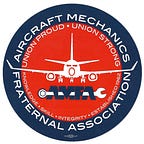What Happens When Planes Are Taken Out Of Service?
Here’s why aircraft mechanics are still crucial to the process
Like many other industries in America, the aviation industry is facing unprecedented challenges amid the coronavirus crisis. In addition to the added safety precautions, the loss of revenue from fewer passengers has caused many more airplanes to be grounded than what would be typical during an average time period. In addition, airlines don’t know exactly when the grounded planes will be needed again — with that unknown factor posing another significant challenge.
So what happens when planes are taken out of service? For one, aircraft maintenance technicians, like the mechanics AMFA represents at Alaska Airlines, Horizon Air and Southwest Airlines, are still vital to the process. While flight attendants and pilots are not staffed on parked planes, maintenance is still necessary.
There are typically two different forms of “parked” airplanes. There is short-term active parking, when the aircraft is maintained in a ready to fly condition, and long-term parking, in which the aircraft is essentially stored and retired. During both types of parking or storage, maintenance occurs at scheduled intervals — typically every seven days - with the difference being that, in active parking, the various aircraft systems are inspected, operated, or exercised more frequently, and in greater depth than during prolonged parking or long term storage. During prolonged parking the aircraft has its engine “pickled”, landing gear lubed, control cables lubed, and protected more heavily from the elements. Normally scheduled maintenance tasks are not required to be accomplished during the parking or storage periods, but must be accomplished at the end of the period and prior to flight, in most cases.
Another period of maintenance occurs when the planes return to service — a full inspection must take place before that can happen.
That’s how typical maintenance is performed — but this crisis is not typical. The sheer amount of work required to return an aircraft to flying status, from the manufacture requirements to the unaccomplished tasks that would be done during normal flying, is what complicated things. In addition, there are all the variables such as available tooling, equipment, materials, manpower, proficiency, locations, weather, conflicting tasks, and more. These planes now are in limbo — and the uncertainty of when they will be un-parked means the vast undertaking will only get larger and more complicated the longer they sit during the COVID-19 crisis.
During this period, parked planes in some cities are seeing the typical seven-day rotation of maintenance, while others are seeing an increased rotation of three days, and others are seeing 14- or 28-days.
Meanwhile, engineers are taking extra precautions when going through their maintenance procedures relating to the parked planes. We are taking every opportunity to make sure as many planes are clean, and green for use. Masks and gloves now are a requirement.
The bottom line is, during this crisis, the expert mechanics are still working to service our planes — to make aircraft safe for crews and passengers, even if those planes are temporarily parked.
Safety is our number one priority — and safety in the air (or parked for the time being) begins with quality maintenance on the ground.
